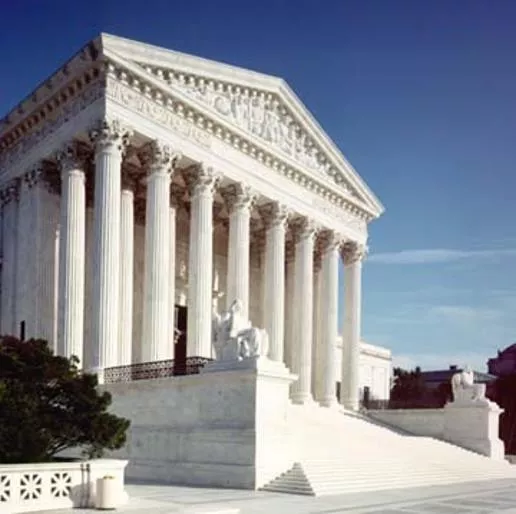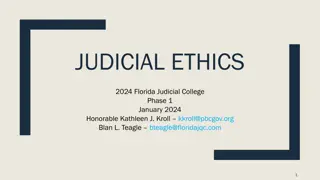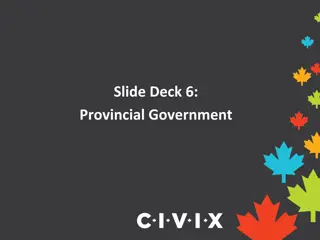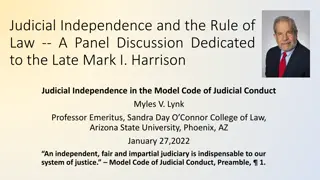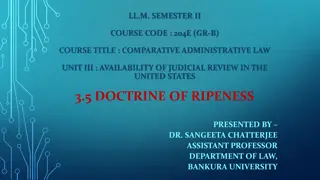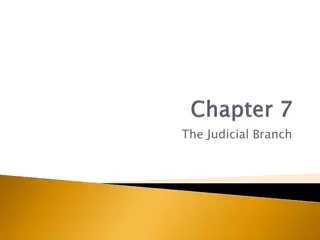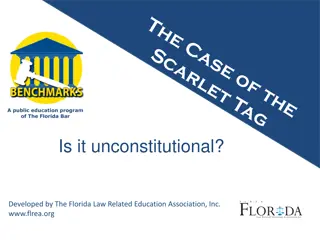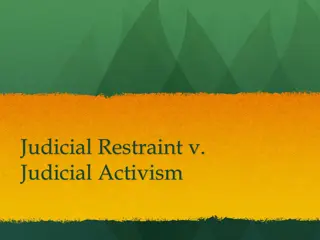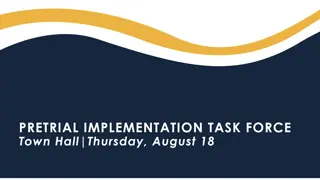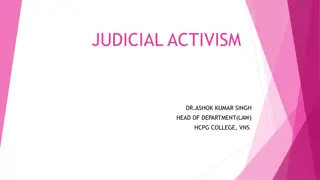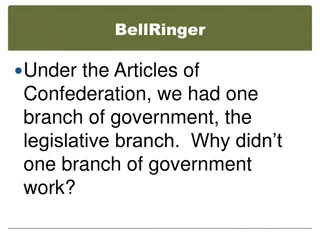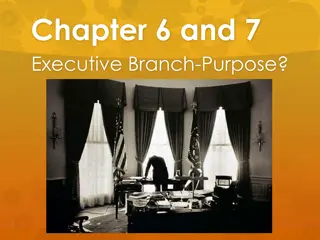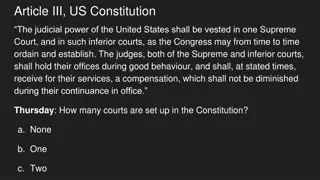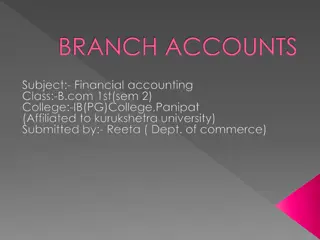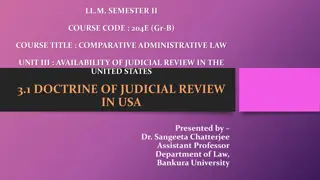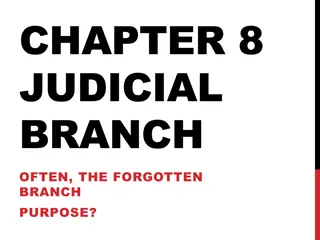The Judicial Branch of Government
The Judicial Branch, established by Article III of the Constitution, is vital for interpreting laws, upholding the Constitution through judicial review, and providing checks and balances on the legislative and executive branches. The Supreme Court, alongside lower federal courts, plays a crucial role in ensuring the legal system's integrity and fairness.
Download Presentation

Please find below an Image/Link to download the presentation.
The content on the website is provided AS IS for your information and personal use only. It may not be sold, licensed, or shared on other websites without obtaining consent from the author.If you encounter any issues during the download, it is possible that the publisher has removed the file from their server.
You are allowed to download the files provided on this website for personal or commercial use, subject to the condition that they are used lawfully. All files are the property of their respective owners.
The content on the website is provided AS IS for your information and personal use only. It may not be sold, licensed, or shared on other websites without obtaining consent from the author.
E N D
Presentation Transcript
Welcome to the Judicial Branch Warm Up : 11/11/14 What is the most important thing to know about the Judicial Branch?
Judicial Branch Article III of the Constitution established the judicial branch of government with the creation of the Supreme Court. This court is the highest court in the country and vested with the judicial powers of the government. There are lower Federal courts but they were not enumerated in the Constitution. Congress deemed them necessary and established them using power granted from the Constitution.
Judicial Review Courts decide arguments about the meaning of laws, how they are applied, and whether they violate the Constitution (aka judicial review) Judicial Review is this process that the judiciary uses to provide checks and balances on the legislative and executive branches.
Judicial Review Judicial review is not an enumerated power given to the courts but it is an implied power. In Marbury v. Madison (1803), the courts' power of judicial review was clearly articulated.
Basic Characteristics The judicial branch hears cases that challenge or require interpretation of the legislation passed by Congress and signed by the President. Consists of the Supreme Court and the lower federal courts. Appointees to the federal bench serve for life or until they voluntarily resign or retire.
Basics The Supreme Court is the most visible of all the federal courts. The number of Justices is determined by Congress rather than the Constitution, and since 1869, the Court has been composed of one Chief Justice and eight Associate Justices. Justices are nominated by the President and confirmed by the Senate.
Interpreting the Law Primary function of courts in general and Supreme Court in particular Mechanical jurisprudence the view of judging Laws often ambiguous
Legal Interpretation Judges base decisions on precedents, laws Explain interpretations by invoking generally accepted legal standards or yardsticks Can sometimes explain decisions by the literal meaning of the words of text in question
Legal Interpretation May refer to intent of the framers Previous court cases/precedents May base decisions on social or political needs **All enhance the credibility of decisions
Court Jurisdiction 1. A case that is heard on original jurisdiction originates or starts in that court. It has not previously been heard in a lower court. A case heard on appellate jurisdiction has already been heard elsewhere, and it is now being heard on appeal. 2.
Jurisdiction Federal courts have jurisdiction over cases involving federal parties (example: ambassadors, leaders, etc) or federal questions (examples: federal laws or treaties, interpretation of constitutional law)
Supreme Court Justices Meet the Supreme Court Justices
Warm Up- Why is the Judicial System so important to understand? How and why did the Framers distribute power in the Constitution?
Supreme Court in review Only court explicitly outlined in Constitution Membership fixed by Congress Since 1869 the Court has had 9 members, including a chief justice and eight associate justices 6 members are needed for quorum
Supreme Court in review President nominates Lifetime appointment
Supreme Court Process 1. 2. 3. 4. At meeting, they speak in descending order of seniority. Chooses cases no independent data, relies on briefs Oral arguments heard over seven 2-week sessions Conference Days Private meetings/deliberation 5. Take tentative vote in ascending order of seniority 6. Assign opinion writing drafted and circulated to fellow justices for comment
Judicial Activism When a judge is active in exercising authority beyond their prescribed power Claims that Judges Legislate from the bench rather than review and referee Loose interpretation of the Constitution; when judges make decisions based on personal notions of societal needs Brown v. Board 1954; Roe v. Wade 1973
Judicial Restraint Suggests that judges limit the exercise of their power (and not beyond, as practitioners of judicial activism may) Strict interpretation of the Constitution Adhere to precedents set by previous decisions in other cases District of Columbia vs. Heller (2008)
Journal Judicial Restraint Follow a strict interpretation of the Constitution Believe judges should also follow precedent Judicial Activism Loosely interpret and apply the Constitution based on ongoing changes and values.
Marbury v. Madison
Background Thomas Jefferson (Democratic- Republican) defeats John Adams (Federalist) in election of 1800 Revolution of 1800 huge victory for D/R
Background Federalist Reaction Occurs after election and before inauguration Bitter over defeat Create new federal judgeships and PACK THE COURT
Key Players Marbury, Madison and others William Marbury appointed Justice of Peace for D.C. by outgoing president (Adams) Problem arises when his commission is not delivered by James Madison (Jefferson s Secretary Of State)
Marburys Reaction Marbury takes case to Supreme Court seeking writ of mandamus Writ of mandamus court order compelling government officer to perform an act, which that office has a clear legal duty to perform
Supreme Court Decision 1. Court refuses Marbury s request for writ of mandamus. Why? 2. Court found Judiciary Act in conflict with Constitution (Article III Section 2, Clause 2)
Supreme Court Decision Marshall bases his decision on three propositions 1. Constitution is supreme law of the land (Article VI Clause 2) 2. All acts of government (legislative, executive, etc.) are subordinate to the supreme law and cannot conflict with it
Supreme Court Decision 3. Judges are sworn to enforce the provisions of the Constitution and therefore must refuse to enforce any government action they find to be in conflict with it. (Judicial Review is established)
According to Marshalls ruling in Marbury v. Madison, the judiciary is the guardian of the Constitution Judicial review is controversial because Americans disagree on how the courts should use this power
Amending the Constitution The Framers of the Constitution realized that, inevitably, changes would have to be made in the document they wrote 27 amendments Article V Formal amendment process four (4) methods Proposal and ratification
Federalism and Popular Sovereignty The formal amendment process emphasizes the federal character of the governmental system Proposal takes place at the national level and ratification is a state-by- state matter When the Constitution is amended, that action represents the expression of the people s sovereign will
What is this political cartoon implying? Journal
Supreme Court Justices Vary in their political and legal philosophies... Judicial Activism Loosely interpret and apply the Constitution based on ongoing changes and values. Judicial Restraint Follow a strict interpretation of the Constitution Believe judges should also follow precedent They have the POWER to declare acts and laws unconstitutional
Application You Pick! Pick one and apply pretending to be the voice of the Judicial Branch Poem (at least 15 lines) Hint: you could break this up into sections for different ideas Song (at least 15 lines) Hint: you could break this up into sections for different ideas Speech (at least 15 lines) MAKE YOUR VOICE HEARD! Humor is appreciated
The Judicial Branch Reading Read ALL OF THE INSTRUCTIONS and answer the questions Whatever you don t finish will become homework
Happy Thursday! Do now: Agenda: Write down one question that you guarantee will be on the Unit test for each branch of the government Do now Share out Gallery Walk Practice Quiz Review Game Closure
The Federal Courts are part of the Judicial Branch, one of three major branches in the federal government. What is the purpose of the judicial branch? To create laws To enforce laws To apply laws to the circumstances of a case All of the above

 undefined
undefined



